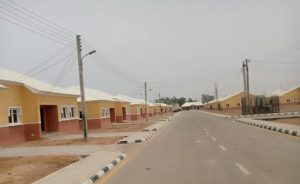Building industry experts in Nigeria are calling for a shift toward sustainable building materials. The fourth International Housing and Construction Fair, recently held at the University of Ibadan, saw experts and stakeholders gather to discuss the importance of green building technologies to making housing sustainable and affordable. Only by embracing eco-friendly technology can the country successfully meet global housing standards.

Making houses sustainable and affordable
Traditional building materials like cement and sand are expensive, with prices only continuing to increase. In addition to being eco-friendly, modern materials, on the other hand, also offer the benefit of being cost-effective. As such, they have the potential to end Nigeria’s current housing shortage.
“We are looking at how we can metamorphose from the orthodox building materials that are making the price of housing expensive. We are exploring other technologies like sawdust, bamboo, containers and it is working,” said event organiser, Rotimi Shodimu.
Straw is another eco-friendly option now used in construction all over the world from Africa to Australia. Despite its outward appearance, straw is strong and durable, and can help build well-insulated homes that keep heat loss to a minimum.
Bamboo revolution
“There is the Asian revolution where they are exploring alternative building materials. There is cement bamboo technology, which is a technology that has not been explored,” Shodimu commented further, referring to Asia’s increasing use of treated bamboo and plastered cement in building construction.
He added: “We had a sample of cement bamboo technology in Ibadan, and it was highly successful and we are looking at replicating those houses and it is what Nigerians can benefit from and become homeowners in the near future. It is housing technology using a treated bamboo plastered cement. So, the superstructure is treated bamboo. It is a cheaper option. With the kind of collaboration we are putting in place, if the government can support us, we can have a three-bedroom unit for N3 million or less with that technology. We have built one in Olorunda, Ibadan.”
Green roofs
But bamboo isn’t the only sustainable building material showing real promise. “In France, grass is being used as the roof of buildings,” Shodimu continued.
Green roofs covered in vegetation play a key role in increasing biodiversity, as well as help lower energy use; with these roofs, less energy is needed to cool buildings over summer, and keep them warm over winter.
Dr. Folashade Yemi-Esan, Head of Civil Service of the Federation, also highlighted the importance for the government and all building industry experts to commit to adopting green technologies. Public/private partnerships are key to building affordable, comfortable, quality, safe, and sustainable housing, she said.
Mr. Bimbo Kolade, second national president of the Nigeria Institute of Building, was also particularly concerned about the current lack of cheap housing across the country. “There is a need for a national housing policy that engenders sustainability and affordability,” he commented in support of all speakers in attendance at the event.
By Jackie Edwards
